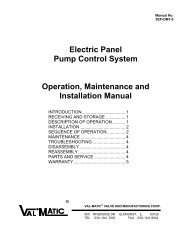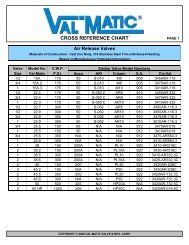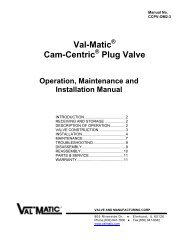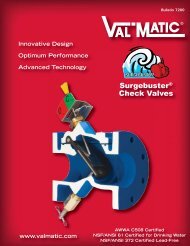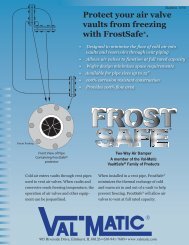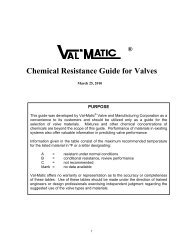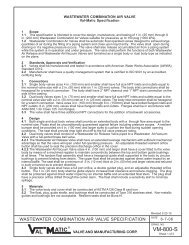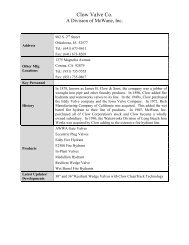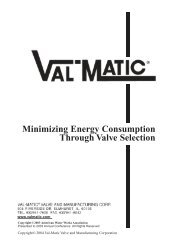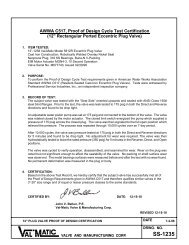Manual Actuators.pdf - Val-Matic Valve and Manufacturing Corp.
Manual Actuators.pdf - Val-Matic Valve and Manufacturing Corp.
Manual Actuators.pdf - Val-Matic Valve and Manufacturing Corp.
Create successful ePaper yourself
Turn your PDF publications into a flip-book with our unique Google optimized e-Paper software.
MANUAL ACTUATORSINTRODUCTIONButterfly <strong>and</strong> ball valves are typically supplied with either a traveling nut or worm geartype actuator. Both types are listed in the applicable AWWA <strong>Val</strong>ve St<strong>and</strong>ards, C504<strong>and</strong> C507. Each type has some important characteristics that affect the performanceof the valve assembly <strong>and</strong> should be understood before selecting the best gear for aparticular application.TRAVELING NUT ACTUATORSThe first type of actuator often provided is the traveling nut actuator. It has beenaround for over 50 years <strong>and</strong> is provided in two designs: the slotted lever <strong>and</strong> the linklever.The traveling nut actuator was created to match the torque characteristics ofbutterfly <strong>and</strong> ball valves, which may have high seating torque on small to mediumsized valves. Therefore, a higher mechanical advantage at the end of travel is oftendesirable.The traveling nut actuator consists of asealed housing, threaded stem, threadednut, link, <strong>and</strong> lever. As the threaded rod isturned with the h<strong>and</strong>wheel, the nut is drivento the left <strong>and</strong> right <strong>and</strong> supported by milledslots in the housing <strong>and</strong> cover of theactuator. The nut in turn drives the link <strong>and</strong>lever. When the nut is on the left side of theNUThousing in the photo, the link is near thevertical orientation. At this location, travelof the nut provides a small change in leverrotation. Hence, at the left end(closed position) the mechanical advantageof the actuator can be twice that in the center or right position. The traveling nut geartherefore matches the torque requirements of the valve. A traveling nut operation canvary from 10 to 100 turns <strong>and</strong> for large valves (i.e. greater than 36 in.), spur gears orbevel gears are provided.The closed <strong>and</strong> open stops of these actuators are typically threaded nuts that arepinned to the threaded stem. Because, a high amount of torque can be resistedbetween two nuts jammed together <strong>and</strong> because the stop design does not apply aload to the housing, the stops are usually rated to 450 ft-lbs. This high torque ratingprevents many valve failures in buried service. <strong>Val</strong>-<strong>Matic</strong> offers a special externallyadjustableclosed stop where the adjustment nut extends through the housing for easyaccess.1VALVESHAFTCLOSEDSTOP



